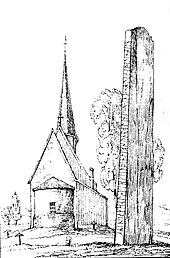Oddernesstein
The Oddernesstein (N 210) is a rune stone in the church of Oddernes in Lund , a district of Kristiansand in Fylke Agder in Norway . The stone originally stood east of the church, but was moved to the church in 1990.
The stone was first described in 1639 by Bishop Thomas Cortsøn Wegener . This was commissioned by Ole Worm (1588-1654), who was preparing his Danicorum monumentorum Libri Sex , and made copies of 29 rune stones for him, including a description and drawing of the Oddernes stone and its two inscriptions.
The slim, flat rune stone is about 3.5 m high and tapers evenly upwards on the wider side. It is about 65 cm wide at the bottom and 40 cm wide at the top. The thickness is around 17 to 12 cm.
The runic inscriptions are on the southern narrow side and the western broad side. They are written with the younger runes and are dated from 1030 to 1050 AD. According to the literature, the inscription on the broad side should read: “Nerið's son is this stone.” The wording on the narrow side is more controversial: “Eyvind, Olaf's godson (note: Olaf the saint or Olav skakke) built this church on his Heritage."
The church built by Eyvind Lambi (or Lamb) on Oddernes must have been a wooden church. The current church was built around 1100 at the earliest, probably even a little later. No traces of Eyvinds or a later stone church have been found.
Web links
- Description on kulturminnesok.no ( Bokmål ) be
- Oddernessteinen on arkeologi.blogspot.de
- Description of Odderne Church and Oddernes stones on agderkultur.no
Coordinates: 58 ° 9 ′ 34.9 ″ N , 8 ° 0 ′ 49.1 ″ E

